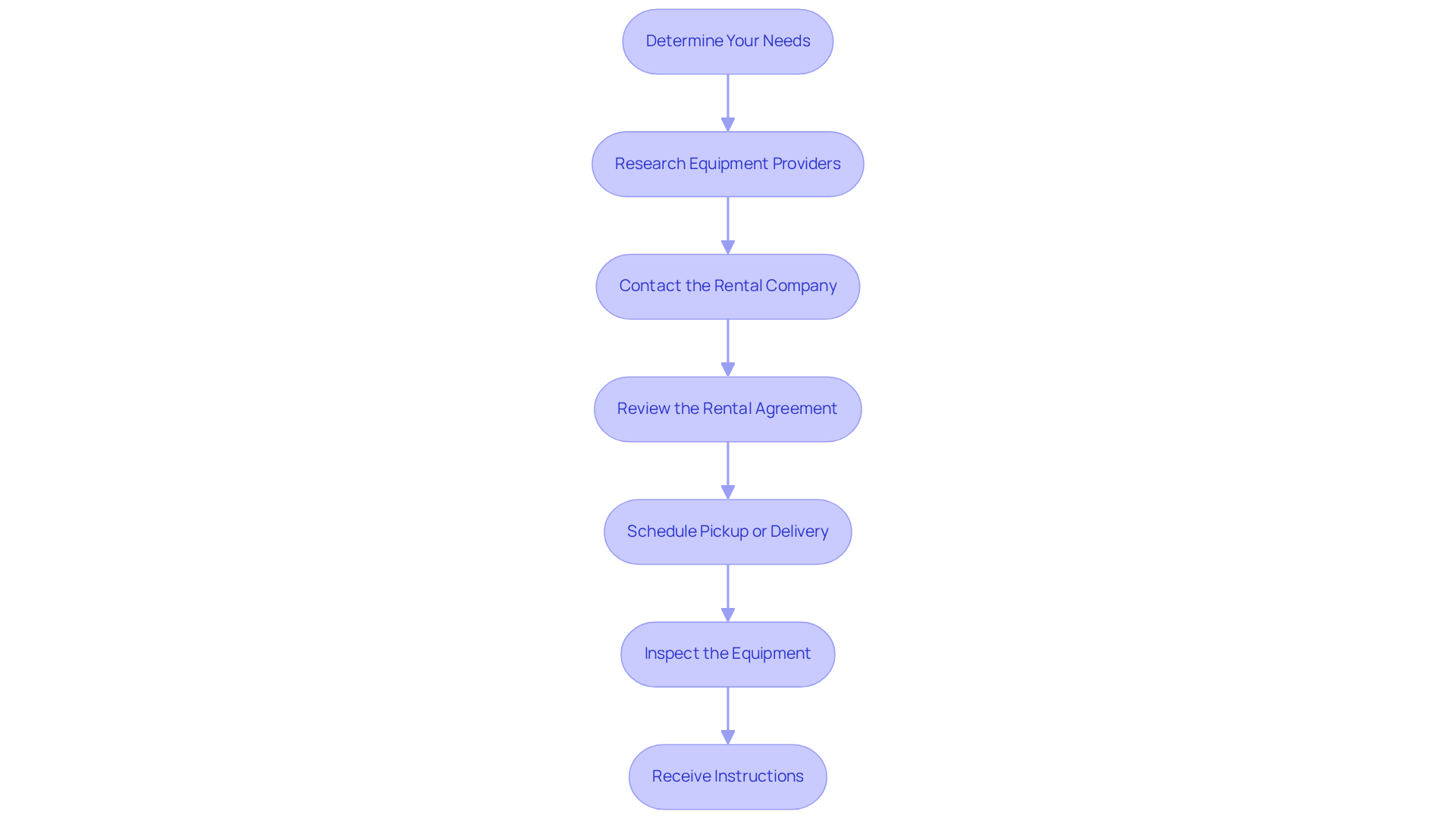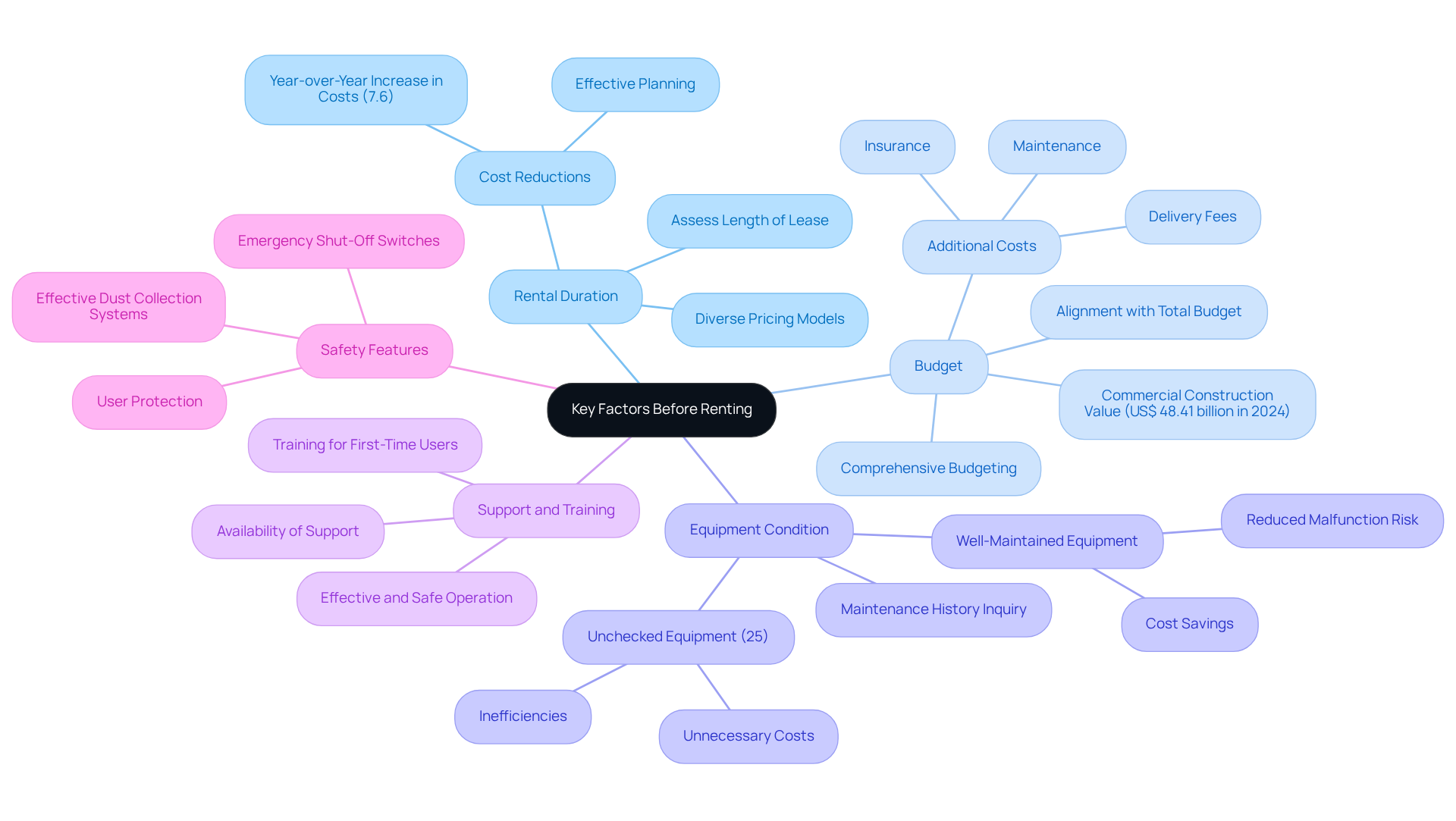Overview
To rent a concrete polisher for your project, it is essential to follow a systematic process.
- Assess your needs
- Research rental providers
- Understand the rental agreement
This article details this process, emphasizing the importance of key factors such as rental duration, budget, and equipment condition. By considering these elements, you can ensure an efficient and successful rental experience.
Key Highlights:
- Concrete polishers are specialised machines used for grinding and polishing cement surfaces, available in handheld and walk-behind models.
- Types of concrete grinding machines include single-head, dual-head, and planetary grinders, each suited for different project sizes.
- Applications of concrete polishers span residential, commercial, and industrial settings, effectively removing imperfections and achieving high-gloss finishes.
- Benefits of using concrete polishers include enhanced durability, reduced maintenance, and improved aesthetic appeal, with a projected market growth to $3.7 billion by 2031.
- The rental process involves determining project needs, researching providers, contacting rental companies, reviewing agreements, scheduling equipment pickup or delivery, inspecting the equipment, and receiving operational instructions.
- Key factors to consider before renting include rental duration, budget, equipment condition, support and training, and safety features.
Introduction
Navigating the world of concrete polishing can indeed present challenges, particularly given the multitude of machines available and their specific applications. A thorough understanding of the nuances of concrete polishers not only elevates the quality of a project but also significantly enhances its overall efficiency and aesthetic appeal. Yet, how does one successfully rent the appropriate equipment amidst a landscape filled with choices and potential pitfalls? This guide demystifies the rental process, outlining essential steps and key considerations to ensure that the right concrete polisher is chosen for any project, thereby paving the way for success.
Understand Concrete Polishers and Their Uses
Surface grinding machines represent specialized tools meticulously engineered to grind and polish cement surfaces, delivering a smooth and glossy finish. Available in various configurations, these machines include handheld models for smaller tasks and larger walk-behind variants designed for extensive areas. Understanding the specific applications of these machines is paramount for executing tasks effectively.
Types of Grinding Machines: It is essential to familiarize yourself with the diverse types of concrete grinding machines, such as single-head, dual-head, and planetary grinders. Each type boasts distinct advantages tailored to the size and nature of your project. For example, planetary grinders excel in large areas, effectively covering more ground quickly and evenly.
Applications: Concrete finishing tools serve as versatile instruments across a myriad of settings, including residential flooring, commercial spaces, and industrial environments. They are adept at removing imperfections, preparing surfaces for coatings, and achieving a high-gloss finish. In residential applications, polished flooring is increasingly favored for its durability and modern aesthetic, while in commercial settings, it withstands heavy foot traffic and offers ease of maintenance.
Benefits: Employing a cement polisher significantly enhances surface durability, reduces maintenance demands, and elevates aesthetic appeal. A recent case study in a bustling retail environment illustrated that polished cement not only improved the store's appearance but also minimized cleaning efforts, resulting in substantial long-term financial savings. Recognizing these advantages can facilitate discussions with stakeholders or clients regarding choices to rent concrete polisher, especially as the global polished market is projected to reach $3.7 billion by 2031, expanding at a CAGR of 5.3% from 2022 to 2031. This growth underscores the increasing demand for refined cement in both residential and commercial applications, establishing it as a strategic option for construction projects.

Follow the Step-by-Step Rental Process
To rent a concrete polisher effectively, follow these essential steps:
- Determine Your Needs: Begin by evaluating the extent of your project to identify the type of surface finisher required. Consider crucial factors such as the size of the area to be polished and the desired finish. This initial assessment is vital for ensuring you select the right equipment for your specific needs.
- Research Equipment Providers: Next, look for reputable machinery leasing companies in your area. For instance, EZ Equipment Rental offers a diverse range of machines, including boom lifts, forklifts, and mini excavators. It’s advisable to check their inventory for available rent concrete polishers and read customer reviews to gauge their reliability. This research will help you make an informed decision.
- Contact the Rental Company: Inquire about how to rent a concrete polisher, including availability, terms, and pricing from EZ Equipment Rental. Be prepared to discuss your project requirements in detail. Their store hours are Monday to Friday from 7:30 AM to 5:30 PM and Saturday from 7:30 AM to 5:00 PM, ensuring convenient access for your borrowing needs.
- Review the Rental Agreement: It is crucial to carefully read the rental agreement. Pay close attention to terms regarding rental duration, fees, and responsibilities for maintenance and cleaning. Understanding these details will help you avoid any potential issues.
- Schedule Pickup or Delivery: Arrange for either pickup or delivery of the equipment. If you plan to pick it up yourself, ensure you have the necessary transportation. This step is essential for a smooth rental experience.
- Inspect the Equipment: Before taking possession, inspect the polisher for any damage or issues. Ensure it is in good working order to avoid complications during your task. A thorough inspection can save you time and trouble later on.
- Receive Instructions: Finally, request operational instructions and safety guidelines from the leasing company. This ensures you use the equipment correctly and safely, maximizing efficiency and minimizing risk during your project.

Consider Key Factors Before Renting
When you rent a concrete polisher, several key factors must be meticulously considered to ensure a successful project outcome.
- Rental Duration: Assess the length of time you will need the polisher. Leasing firms generally provide diverse pricing models depending on the duration of the lease. Understanding your schedule can lead to considerable cost reductions. In Q3 2023, the anticipated year-over-year increase in construction equipment leasing expenses was 7.6%, highlighting the importance of planning your leasing duration effectively.
- Budget: Establish a comprehensive budget for the lease, factoring in potential additional costs such as delivery fees, insurance, and maintenance. It is vital that the rental aligns with your total budget for the undertaking, especially as the commercial construction sector is projected to reach a value of US$ 48.41 billion in 2024, with a growth rate of 4.3% CAGR from 2024 to 2034.
- Equipment Condition: Inquire about the maintenance history of the rented concrete polisher. Equipment that has been well-maintained is less likely to malfunction, saving both time and money during your project. Additionally, be aware that approximately 25% of rented equipment may go unchecked, which can lead to inefficiencies and unnecessary costs.
- Support and Training: Determine if the rental company offers support or training on equipment usage. This is particularly advantageous for first-time users, ensuring they can operate the device effectively and safely.
- Safety Features: Verify that the polisher is equipped with essential safety features, such as emergency shut-off switches and effective dust collection systems. These features are crucial for protecting users and maintaining a safe working environment.
By considering these factors, you can make informed decisions that enhance project efficiency and budget management.

Conclusion
Renting a concrete polisher is not just a choice; it is a strategic decision that can significantly enhance the quality and efficiency of your flooring projects. By understanding the various types of polishers available and their specific applications, individuals can select the right equipment tailored to their needs. This knowledge aids in achieving a superior finish and ensures that the investment in rental equipment pays off in terms of durability and aesthetic appeal.
This article outlines a comprehensive, step-by-step approach to renting a concrete polisher. Key steps include:
- Determining project requirements
- Researching rental providers
- Carefully reviewing rental agreements
Additionally, factors such as rental duration, budget considerations, equipment condition, and available support are crucial for ensuring a successful rental experience. Each of these elements plays a vital role in maximizing the benefits of using a concrete polisher and avoiding potential pitfalls.
Ultimately, making informed decisions when renting a concrete polisher can lead to enhanced project outcomes and significant cost savings. As the demand for polished concrete continues to rise across various sectors, understanding how to navigate the rental process effectively becomes increasingly important. Embrace this opportunity to elevate your project by ensuring you are well-equipped with the right tools and knowledge to achieve the desired results.
Frequently Asked Questions
What are concrete polishers and what do they do?
Concrete polishers are specialized tools designed to grind and polish cement surfaces, providing a smooth and glossy finish.
What types of concrete grinding machines are available?
There are various types of concrete grinding machines, including single-head, dual-head, and planetary grinders. Each type has distinct advantages suited for different project sizes and needs.
What is the advantage of using planetary grinders?
Planetary grinders are particularly effective for large areas as they cover more ground quickly and evenly.
In what settings are concrete finishing tools commonly used?
Concrete finishing tools are used in various settings, including residential flooring, commercial spaces, and industrial environments.
What are some common applications for concrete polishers?
Common applications include removing imperfections, preparing surfaces for coatings, and achieving a high-gloss finish.
Why is polished flooring preferred in residential applications?
Polished flooring is favored in residential applications for its durability and modern aesthetic.
How do polished surfaces perform in commercial settings?
In commercial settings, polished surfaces can withstand heavy foot traffic and offer ease of maintenance.
What are the benefits of using a cement polisher?
Benefits of using a cement polisher include enhanced surface durability, reduced maintenance demands, and improved aesthetic appeal.
What did a recent case study reveal about polished cement in retail environments?
A case study showed that polished cement improved the store's appearance and minimized cleaning efforts, leading to significant long-term financial savings.
What is the projected growth of the global polished concrete market?
The global polished concrete market is projected to reach $3.7 billion by 2031, expanding at a CAGR of 5.3% from 2022 to 2031.




